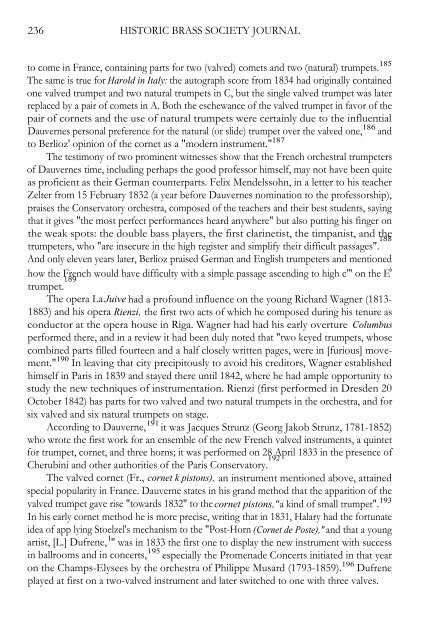THE ROMANTIC TRUMPET - Historic Brass Society
THE ROMANTIC TRUMPET - Historic Brass Society
THE ROMANTIC TRUMPET - Historic Brass Society
Create successful ePaper yourself
Turn your PDF publications into a flip-book with our unique Google optimized e-Paper software.
236 HISTORIC BRASS SOCIETY JOURNAL<br />
to come in France, containing parts for two (valved) comets and two (natural) trumpets. 185<br />
The same is true for Harold in Italy: the autograph score from 1834 had originally contained<br />
one valved trumpet and two natural trumpets in C, but the single valved trumpet was later<br />
replaced by a pair of comets in A. Both the eschewance of the valved trumpet in favor of the<br />
pair of cornets and the use of natural trumpets were certainly due to the influential<br />
Dauvernes personal preference for the natural (or slide) trumpet over the valved one, 186 and<br />
to Berlioz' opinion of the cornet as a "modern instrument." 187<br />
The testimony of two prominent witnesses show that the French orchestral trumpeters<br />
of Dauvernes time, including perhaps the good professor himself, may not have been quite<br />
as proficient as their German counterparts. Felix Mendelssohn, in a letter to his teacher<br />
Zelter from 15 February 1832 (a year before Dauvernes nomination to the professorship),<br />
praises the Conservatory orchestra, composed of the teachers and their best students, saying<br />
that it gives "the most perfect performances heard anywhere" but also putting his finger on<br />
the weak spots: the double bass players, the first clarinetist, the timpanist, and the<br />
trumpeters, who "are insecure in the high register and simplify their difficult passages". 188<br />
And only eleven years later, Berlioz praised German and English trumpeters and mentioned<br />
how the French would have difficulty with a simple passage ascending to high c'" on the E 6<br />
trumpet. 189<br />
The opera La Juive had a profound influence on the young Richard Wagner (1813-<br />
1883) and his opera Rienzi, the first two acts of which he composed during his tenure as<br />
conductor at the opera house in Riga. Wagner had had his early overture Columbus<br />
performed there, and in a review it had been duly noted that "two keyed trumpets, whose<br />
combined parts filled fourteen and a half closely written pages, were in [furious] movement."<br />
190 In leaving that city precipitously to avoid his creditors, Wagner established<br />
himself in Paris in 1839 and stayed there until 1842, where he had ample opportunity to<br />
study the new techniques of instrumentation. Rienzi (first performed in Dresden 20<br />
October 1842) has parts for two valved and two natural trumpets in the orchestra, and for<br />
six valved and six natural trumpets on stage.<br />
According to Dauverne, 191 it was Jacques Strunz (Georg Jakob Strunz, 1781-1852)<br />
who wrote the first work for an ensemble of the new French valved instruments, a quintet<br />
for trumpet, cornet, and three horns; it was performed on 28 April 1833 in the presence of<br />
Cherubini and other authorities of the Paris Conservatory. 192<br />
The valved cornet (Fr., cornet k pistons), an instrument mentioned above, attained<br />
special popularity in France. Dauverne states in his grand method that the apparition of the<br />
valved trumpet gave rise "towards 1832" to the cornet pistons," a kind of small trumpet". 193<br />
In his early cornet method he is more precise, writing that in 1831, Halary had the fortunate<br />
idea of app lying Stoelzel's mechanism to the "Post-Horn (Cornet de Poste)," and that a young<br />
artist, [L.] Dufrene, 1 " was in 1833 the first one to display the new instrument with success<br />
in ballrooms and in concerts, 195 especially the Promenade Concerts initiated in that year<br />
on the Champs-Elysees by the orchestra of Philippe Musard (1793-1859). 196 Dufrene<br />
played at first on a two-valved instrument and later switched to one with three valves.
















